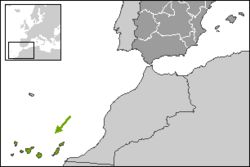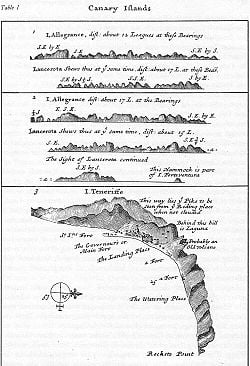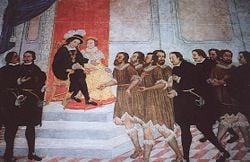Canary Islands
- This article is about the islands in the Atlantic Ocean. For other uses of the term, see Canaries.
| |||||
| Anthem: Arrorró | |||||

| |||||
| Capital | Las Palmas de Gran Canaria and Santa Cruz de Tenerife | ||||
| Official language(s) | Spanish | ||||
| Area – Total – % of Spain |
Ranked 13th 7,447 km² 1.5% | ||||
| Population – Total (2006) – % of Spain – Density |
Ranked 8th 1,995,833 4.5% 268/km² | ||||
| Demonym – English – Spanish |
Canary Islander (Canarian) canario/a | ||||
| Statute of Autonomy | August 16, 1982 | ||||
| Parliamentary representation – Congress seats – Senate seats |
15 13 | ||||
| President | Adán Martín Menis (CC) | ||||
| ISO 3166-2 | included in ES | ||||
| Gobierno de Canarias | |||||
The Canary Islands IPA: /kəˈnæɹɪ ˈaɪləndz/ (Spanish Islas Canarias /ˈis.las kaˈnarjas/) (28° 06'N, 15° 24'W) are an archipelago of the Kingdom of Spain consisting of seven islands of volcanic origin in the Atlantic Ocean. They are located off the north-western coast of Africa (Morocco and the Western Sahara). They form an autonomous community of Spain.
Etymology
In a Berber dialect of north Africa, the islands are called Tkanaren [citation needed]. The islands may derive their name from this word, or possibly from the Latin term Insularia Canaria, meaning Island of the Dogs, a name applied originally only to the island of Gran Canaria. It is thought that the dense population of an endemic breed of large and fierce dogs, like the Presa Canario, was the characteristic that most struck the few ancient Romans who established contact with the islands by the sea.
History
Pre-colonial times
When Europeans began to explore the islands they encountered several indigenous populations living at a Neolithic level of technology. Although the history of the settlement of the Canary Islands is still unclear, linguistic and genetic analyses seem to indicate that at least some of these inhabitants shared a common origin with the Berbers of northern Africa. The pre-colonial inhabitants came to be known collectively as the Guanches, although Guanches was originally the name for the indigenous inhabitants of Tenerife.
The islands were known to the Phoenicians, Greeks and Romans, and are mentioned in a number of classical sources. Pliny the Elder describes a Carthaginian expedition to the Canaries, and they may have been the Fortunate Isles of other classical writers. Although largely forgotten in the Western world until their rediscovery, they may have been visited occasionally by Arab and Mediterranean travelers in the Middle Ages.
Spanish conquest
In 1402, the conquest of the islands began, with the expedition of Juan de Bethencourt and Gadifer de la Salle to the island of Lanzarote, Norman nobles who were vassals of Henry III of Castile. From there, they conquered Fuerteventura and Hierro. Béthencourt received the title King of the Canary Islands, but recognized King Henry III as his overlord.
Béthencourt also established a base on the island of Gomera, but it would be many years before the island was truly conquered. The people of Gomera, as well as the Gran Canaria, Tenerife, and La Palma people, resisted the Spanish invaders for almost a century. Between 1448 and 1459, there was a crisis between Castile and Portugal over control of the islands, when Maciot de Bethencourt sold the lordship of Lanzarote to Portugal's Prince Henry the Navigator, an action that was not accepted by the natives or the Castilian residents of the island, who initiated a revolt and expelled the Portuguese. In 1479, Portugal recognized Castilian control of the Canary Islands in the Treaty of Alcaçovas.
The Spanish continued to dominate the islands, but due to the topography and the resistance of the native Guanches, the conquest was not completed until 1495, when the conquest of Tenerife and La Palma was completed by Alonso Fernández de Lugo, after which the Canaries were incorporated into the Castilian kingdom. The Guanches were initially enslaved and gradually absorbed by the Spanish colonizers.
After the conquest
After the conquest, the Spanish imposed a new economic model based on single-crop cultivation— first, sugar cane, then wine, an important trade item with England. In this era, the first institutions of government were founded. Both Gran Canaria, since 6 March 1480 a colony of Castile (from 1556 of Spain), and Tenerife, a Spanish colony since 1495, had separate governors.
The towns of Las Palmas de Gran Canaria and Santa Cruz de Tenerife, became a stopping point for the Spanish conquerors, traders, and missionaries on their way to the New World. This trade route brought great prosperity to some of the social sectors of the islands. The islands became quite wealthy and soon were attracting merchants and adventurers from all over Europe. Magnificent palaces and churches were built on the island of La Palma during this busy, prosperous period. Of particular interest to visitors is the Church of El Salvador, one of the island's finest examples of the architecture of the 1500s.
On the other hand, because of the wealth, the Canaries were frequently attacked by pirates and privateers. The most significant attack took place in 1599, when the Dutch Van der Does attacked the only capital at the time Real de Las Palmas with 74 ships, 12.000 men (the city was possessing 3.500 inhabitants for 8.545 of the island of Gran Canaria), and 150 landing craft. They attacked the Castillo de la Luz, which gave itself up when the city was evacuated. The Canary cavalry pushed the invader back to the zone of Tamaraceite and the Dutch decided to besiege the city, which they achieved after 3 days of assault, demanding the delivery of all its wealth. They received 12 sheep and 3 calves. Furious, the pirate sent 4.000 soldiers to the meeting of the canaries, which had sheltered in Santa Brígida. 300 Canary soldiers who were staying laid an ambush in the Monte Lentiscal and put the Dutch in retreat, making them 150 dead men. The Dutch return to Las Palmas. Van der Does gave orders to plunder and to light fire to the Cathedral and to the city. On having gone out of the same one he went to Maspalomas and then to San Sebastian of La Gomera, he plundered it and was 7 days there. Later he attacks Santa Cruz de La Palma.
Another attack occurred at Santa Cruz de Tenerife, which was attacked by Horatio Nelson (then Rear Admiral of the Blue) on 25th July 1797. Nelson was shot in the right arm with a musketball, fracturing his humerus bone in multiple places. Since medical science of the day counseled amputation for almost all serious limb wounds (to prevent death by gangrene), Nelson lost almost his entire right arm and was unfit for duty until mid-December. This vain attempt to conquer the largest of the seven Canary Islands cost the British almost 400 men, and was their last.
Eighteenth to nineteenth centuries
Because of the crises of single-crop cultivation in the eighteenth century and onward, Spain's American colonies in the nineteenth century caused severe recessions on the islands. A new cash crop, cochineal (cochinilla), came into cultivation during this time, saving the island's economy.
Owing to economic crises in the archipelago, a series of emigrations, primarily for the Americas, took place during the nineteenth and first half of the twentieth centuries. During the Spanish-American War of 1898, the Spanish feared an American assault upon the islands, so fortified them; the assault never came.
Early twentieth century
At the beginning of the 20th century, the English introduced a new cash-crop, the banana, the export of which was controlled by companies such as Fyffes.
The rivalry between the elites of the cities of Las Palmas de Gran Canaria and Santa Cruz de Tenerife for the capital of the islands would lead to the division of the archipelago into two provinces in 1927, though this has not laid to rest the rivalry between the two cities, which continues to this day.
During the time of the Second Spanish Republic, workers' movements with marxist and anarchist ideologies began to develop, led by figures such as Jose Miguel Perez and Guillermo Ascanio. However, outside of a few municipalities, these organizations were a minority.
Franco regime
In 1936, Francisco Franco travelled to the Canaries as General Commandant. From the Canaries, he launched the military uprising of July 17. He quickly took control of the archipelago, with the exception of a few focal points of resistance on the island of La Palma and in the town of Vallehermoso, on Gomera island. Despite the fact that there was never a proper war in the islands, they were one of the places where the post-war repression was most severe. [citation needed]
During the Second World War, Winston Churchill prepared plans for the British seizure of the Canary Islands as a naval base, in the event of Gibraltar being invaded from the Spanish mainland.
Opposition to Franco's regime did not begin to organize until the late 1950s, which experienced an upheaval of groups such as the Communist Party of Spain and the formation of various nationalist, leftist, and pro-independence armed movements, such as the Free Canaries Movement and the MPAIAC.
Today
After Franco's death and the installation of a democratic constitutional monarchy, a bill of autonomy was put forth for the Canaries which was approved in 1982. In 1983, the first autonomous elections were held, and were won by the Spanish socialist party, PSOE. The current ruling party is the Canarian Coalition.
Physical geography
The islands and their capitals are:
| Island | Capital |
|---|---|
| Gran Canaria | Las Palmas de Gran Canaria |
| Tenerife | Santa Cruz de Tenerife |
| Lanzarote | Arrecife |
| La Palma | Santa Cruz de La Palma |
| La Gomera | San Sebastián de La Gomera |
| El Hierro | Valverde |
| Fuerteventura | Puerto del Rosario |
| La Graciosa | Caleta de Sebo |
The nearest island (Fuerteventura) is 108 km from the northwest African coast.
The islands form the Macaronesia ecoregion with the Azores, Cape Verde, Madeira, and the Savage Isles. The Teide volcano on Tenerife is the highest mountain in Spain, and the third largest volcano on Earth. According to the position of the islands with respect to the trade winds, the climate can be mild and wet or very dry. Several native species are laurisilva forests.
Four of Spain's thirteen national parks are located in the Canary Islands, more than any other autonomous community. In the early 90's, Spain's national parks were only five, being four of them the Canarian parks, and the other one Doñana. The parks are:
| Park | Island |
|---|---|
| Parque Nacional de la Caldera de Taburiente | La Palma |
| Garajonay National Park | La Gomera |
| Teide National Park | Tenerife |
| Timanfaya National Park | Lanzarote |
http://www.youtube.com/watch?v=AaQ9rDcSrMk view about Canary Island
Political geography

The Autonomous Community of the Canary Islands consists of two provinces, Las Palmas and Santa Cruz de Tenerife, whose capitals (Las Palmas de Gran Canaria and Santa Cruz de Tenerife) are co-capitals of the autonomous community. Each of the seven major islands is ruled by an assembly named cabildo insular.
The international boundary of the Canaries is the subject of dispute between Spain and Morocco. Morocco does not agree that the laws regarding territorial limits allow Spain to claim for itself sea-bed boundaries based on the territory of the Canaries, because the Canary Islands are autonomous. The boundary is relevant for possible seabed oil deposits and other ocean resource exploitation. Morocco therefore does not formally agree to the territorial boundary; it rejected a 2002 unilateral Spanish proposal.[1] Morocco has also made some vague historical claims to the Canary Islands themselves,[citation needed] but these claims have not been formally pursued.
The Islands have 13 seats in the Senate. Of these, 11 seats are directly elected, 3 for Gran Canaria, 3 for Tenerife, 1 for each other island; 2 seats are indirectly elected by the regional Autonomous Government.
Economy
The economy is based primarily on tourism, which makes up 32% of the GDP. The Canaries receive about 10 million tourists per year. Construction makes up nearly 20% of the GDP and tropical agriculture, primarily bananas and tobacco, are grown for export to Europe and the Americas. Ecologists are concerned that the resources, especially in the more arid islands, are being overexploited but there are still many agricultural resources like tomatoes, potatoes, onions, cochineal, sugarcane, grapes, vines, dates, oranges, lemons, figs, wheat, barley, corn, apricots, peaches and almonds.
The economy is € 25 billion (2001 GDP figures). The islands experienced continuous growth during a 20 year period, up until 2001, at a rate of approximately 5% annually. This growth was fueled mainly by huge amounts of Foreign Direct Investment, mostly to develop tourism real estate (hotels and apartments), and European Funds (near 11 billion euro in the period from 2000 to 2007), since the Canary Islands are labeled Region Objective 1 (eligible for euro structural funds).
The combination of high mountains, proximity to Europe, and clean air has made the Roque de los Muchachos peak (on La Palma island) a leading location for telescopes like the Grantecan.
The islands are outside European Union customs territory, though politically within the EU. The ISO 3166-1 α-2 code IC is reserved for representing them in customs affairs. Goods subject to Spanish customs and excise duties and Value Added Tax (VAT), such as tobacco or electronic goods, are therefore significantly cheaper in the Canaries. Spanish magazines usually have a similar or higher price than in the peninsula since VAT is substituted with air transport costs. The islands do not have a separate Internet country code from the rest of Spain (+34). The currency is the euro.
Canarian time is Western European Time (WET) (or GMT; in summer one hour ahead of GMT). So Canarian time is one hour behind that of peninsular Spain and the same as that of the UK, Portugal and Ireland all year round.
See also
History
- First Battle of Acentejo
- Second Battle of Acentejo
- Alonso Fernández de Lugo
- Tanausu
- Tenerife disaster; prior to the 9/11 attacks, the deadliest commercial aviation disaster in history.
Geography
- La Matanza de Acentejo, Santa Cruz de Tenerife
- Los Llanos de Aridane
- Macaronesia
- Orotava Valley
- Guatiza (Lanzarote)
Culture
- Canarian cuisine
- Salto del pastor (Canary Islands mountain gymnastic folk sport)
- Silbo Gomero language, a whistled language, is an indigenous language, whose existence was known since Roman times.
Natural History
See:- Borgesen, F. 1929. Marine algae from the Canary Islands.III Rhodophyceae. Part II. Cryptonemiales, Gigartinales, and Rhodymeniales. Det Kongelige Danske Videnskabernes Selskabs Biologiske Meddelelser. 8: 1—97.
Neighbors
Notes
- ↑ Field Listing - Disputes - international. CIA World Factbook. Retrieved December 20, 2007.
ReferencesISBN links support NWE through referral fees
- Crosby, Alfred. 1993. Ecological Imperialism : The Biological Expansion of Europe, 900-1900. Cambridge, UK: Cambridge University Press. ISBN 0-521-45690-8.
- Fernández-Armesto, Felipe. 1982. The Canary Islands after the Conquest: The Making of a Colonial Society in the Early-Sixteenth Century. Oxford, UK: Oxford University Press. ISBN 0198218885.
External links
- Official Statistics about Canary Islands. Retrieved December 20, 2007.
- World Statesmen. Retrieved December 20, 2007.
- Old photos Canary Islands and the Canary Islanders. Retrieved December 20, 2007.
- Canary Islands pose little risk of mega-tsunami. Retrieved December 20, 2007.
- The Canary Islands on Google Maps. Retrieved December 20, 2007.
| ||||||||||
| |||||||
Credits
New World Encyclopedia writers and editors rewrote and completed the Wikipedia article in accordance with New World Encyclopedia standards. This article abides by terms of the Creative Commons CC-by-sa 3.0 License (CC-by-sa), which may be used and disseminated with proper attribution. Credit is due under the terms of this license that can reference both the New World Encyclopedia contributors and the selfless volunteer contributors of the Wikimedia Foundation. To cite this article click here for a list of acceptable citing formats.The history of earlier contributions by wikipedians is accessible to researchers here:
The history of this article since it was imported to New World Encyclopedia:
Note: Some restrictions may apply to use of individual images which are separately licensed.





